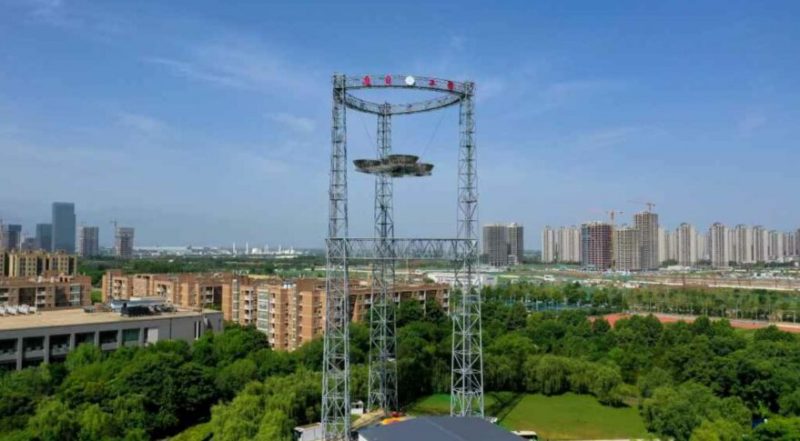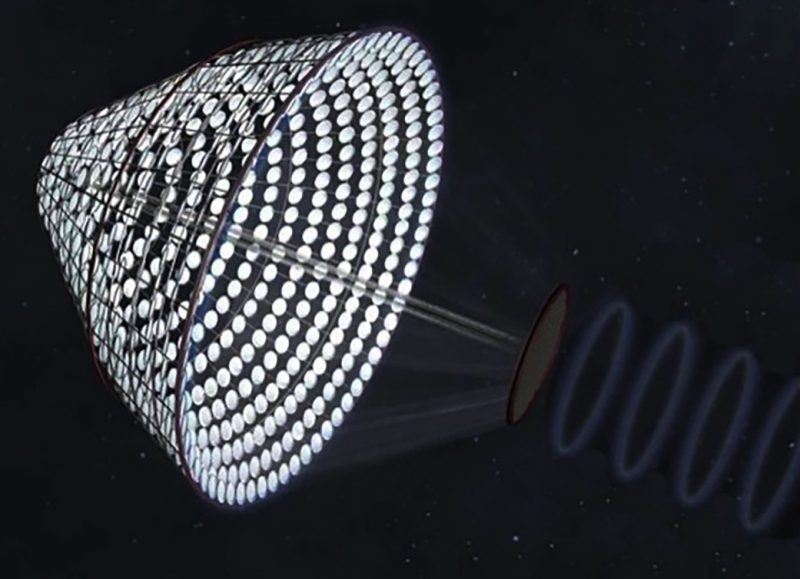
Researchers at Xidian University in the city Xi’an (in north China) say they have successfully passed a test of what they call:
… the world’s first full-link and full-system ground test system for space-based solar power.
Andrew Jones (@AJ_FI on Twitter), a journalist specializing in China’s space program, published the report. He wrote about it at SpaceNews on June 14, 2022. Jones reported that Xidian University carried out the space solar power test via a 246-foot-high (75-meter-high) steel structure located on the university’s south campus. The structure holds subsystems for testing the space-based solar power concept. According to a statement from Xidian University, the tower passed an “acceptance inspection” on June 5. That is, in fact, three years ahead of schedule. Jones reported via SpaceNews:
The facility is designed to collect solar energy and convert it into direct current electricity. This is to then be converted into microwaves for transmission via an antenna over a distance of 55 meters [180 feet].”
Just the start
Indeed, that’s a far cry from the distance needed to transmit solar power collected in Earth orbit to receivers on Earth’s surface. But, it’s a start. Duan Baoyan, a leading Chinese expert in space-based solar power, led the research, Jones said. In addition, Jones quoted Duan Baoyan as saying:
The research on space solar power [here at Xidian University] is currently a hot spot in the world.
However, Duan Baoyan also noted that the realization of space-based solar power would take “generations.”

The long road to space solar power
Space-based solar power stems from an innovative idea in 1968 by aerospace engineer pioneer Peter Glaser. More specifically, he got the idea of collecting energy from sunlight in space and beaming it down to Earth via microwaves. Subsequently, the microwaves are then converted to electrical energy and supplied to earthly power grids. Many space enthusiasts got behind the idea in the 1970s, when physicist Gerard O’Neill at Princeton University incorporated Glaser’s concept into his vision for space colonies. In the 1970s, at the Goldstone Deep Space Communications Complex in California, scientists successfully conducted microwave power transmission experiments.
So, people have been talking about collecting solar power in space – and transmitting it via microwaves to Earth – for, literally, decades.
In addition, the idea is attractive as a way to provide abundant energy for earthly uses. After all, as proponents point out, the sun never sets in space (for the most part). However, no one has found an economically viable way to harvest energy from space and beam it back down to Earth. In particular, this is especially true given present-day space launch costs.
Global research into space solar power is ongoing
But researchers around the globe haven’t stopped working on the problem, however, particularly in the U.S., China, Japan and within the European Space Agency and the United Kingdom Space Agency. In the United States, the leading proponent of the space solar power concept in recent years is John Mankins. He spearheaded what’s called SPS-ALPHA, short for Solar Power Satellite via Arbitrarily Large PHased Array. This is a proposal currently being studied by NASA.
Mankins spoke with Leonard David at Space.com about the space-based solar power concept in 2012. Mankins told David, essentially, that the idea of space solar power as a sustainable energy alternative should be revisited in light of advances such as the dawn of the megaconstellations That is, the idea of using tens of thousands of satellites working together as a network from low-Earth orbit. Notably, the idea is exemplified by SpaceX’s Starlink broadband network. David described Starlink in 2012 as:
… a mass-production effort that now cranks out 30 tons of satellites a month. SpaceX is on course to potentially manufacture 40,000 satellites … and launch all of them.
And in fact, that number of satellites – approximately 40,000 – is still SpaceX’s plan. The company, owned by Elon Musk, exceeded 2,500 Starlink satellites in orbit in May 2022.
Possibilities from megaconstellation technology
Indeed, as Mankins said to Leonard in 2012:
The path to low-cost hardware has been shown. It’s modular and mass-produced. The hurdles of less-expensive launch and lowering hardware costs have been overcome.
“Overcome” might be overstating things. But the concept of space solar power does appear to be on a steady – albeit long – road to fruition.

Bottom line: Space visionaries have talked about space solar power – harvesting solar power from space, where “the sun never sets” – for decades. And, it’s still a long road. But we’re on it, as evidenced by a successful test in June 2022 of “the world’s first full-link and full-system ground test system” for space-based solar power, carried out at Xidian University in northern China.











